Mother’s milk is a magical substance, and the process your body goes through to produce it is pretty awe-inspiring, too. But what’s really going on when you make milk? Here’s the science behind breast milk production and the transformation it requires.
The beginning of a transformation
As every mama knows, when you get pregnant, your body undergoes many changes. Your sense of smell and taste may become supercharged or at least altered; your hormones will surge, and you will gain weight and retain more water as your body prepares to grow and support another life through the gestation process. Along with these changes, your body will prepare to nourish your baby outside of your body by transforming it so that you can produce breast milk. This process, called lactogenesis, begins to occur around the 16th week of pregnancy. Here’s a little window into how the magic happens.
Cascading hormones
- The changes in your body and lactation itself are triggered by hormones, each of which plays a specific role:
- Estrogen and progesterone stimulate the creation of alveoli, the growth of milk ducts, and cause your breasts to grow fuller, but they also block the lactation process until it becomes necessary.
- Human Placental Lactogen (hPL) provides nutrition to your growing fetus during pregnancy (in part by stimulating mama’s appetite!) but also by triggering the growth and development of milk ducts.
- Prolactin signals to your body that it’s time to make milk. In the beginning stages of breastfeeding, as your baby suckles, prolactin will increase each time, alerting your body to produce more milk for the next feed. Once the supply and demand system is established, your body doesn’t need so much prolactin to maintain milk production.
- Oxytocin: Oxytocin helps to push the milk from the alveoli into the milk ducts, so it can then be delivered to your baby.

A sophisticated system
In addition to the hormones necessary for breast milk production, your body must grow cells and structures to support the milk-making process:
-
Alveoli are tiny, hollow sacs where milk is produced.
-
A group of alveoli clustered together is called a lobule.
-
Milk ducts carry the milk from the lobules to the nipple.
-
Pores in your nipples will deliver breast milk to your baby.
From lactogenesis to lactation
Once your body has undergone its metamorphosis and your baby is born, the lactation process can really begin. Estrogen and progesterone levels drop, which allows prolactin signaling to come through loud and clear. Your baby’s suckling will stimulate an increase in oxytocin and prolactin, and as they feed, the volume of milk your body produces will increase dramatically. As you adjust to regular feeding with your baby, your breasts may become full and require frequent emptying--that’s all part of the process!
The perfect food for your baby
Just as your body changes as your baby grows, so will your milk. There are three stages of milk production:
-
Colostrum, a thick, yellowish liquid, is the first type of milk your baby will receive. It’s packed with fats, protein, and important antibodies that will keep your baby healthy until they develop their own.
-
Transitional milk is calorically dense and will help your baby to gain weight and grow.
-
Mature milk includes more water for hydration but also plenty of fat, carbohydrate, and protein to support your baby’s continued growth.
Mamas, we know your body has an incredible delivery system for breast milk, but did you know that Bébé Bru can help you to nourish your baby with perfect nutrition when you can’t be there in person? See how our system works and find out if freeze-drying your breast milk is right for yo.

